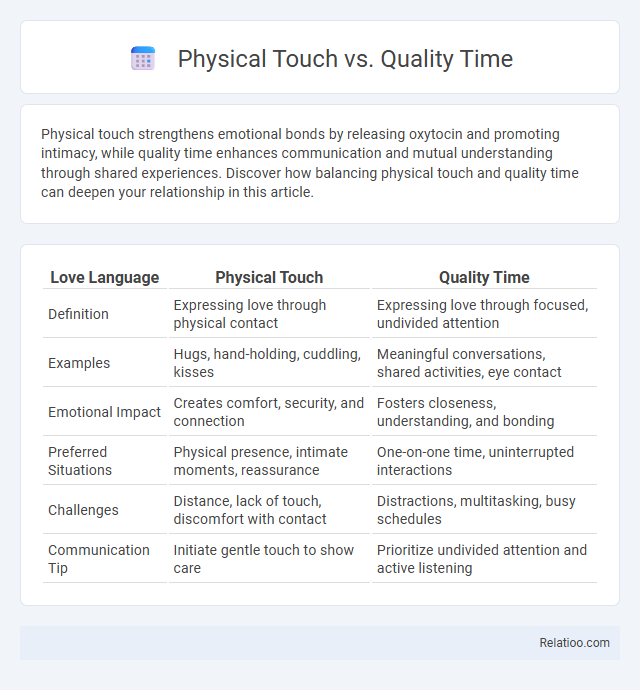Physical touch strengthens emotional bonds by releasing oxytocin and promoting intimacy, while quality time enhances communication and mutual understanding through shared experiences. Discover how balancing physical touch and quality time can deepen your relationship in this article.
Table of Comparison
| Love Language | Physical Touch | Quality Time |
|---|---|---|
| Definition | Expressing love through physical contact | Expressing love through focused, undivided attention |
| Examples | Hugs, hand-holding, cuddling, kisses | Meaningful conversations, shared activities, eye contact |
| Emotional Impact | Creates comfort, security, and connection | Fosters closeness, understanding, and bonding |
| Preferred Situations | Physical presence, intimate moments, reassurance | One-on-one time, uninterrupted interactions |
| Challenges | Distance, lack of touch, discomfort with contact | Distractions, multitasking, busy schedules |
| Communication Tip | Initiate gentle touch to show care | Prioritize undivided attention and active listening |
Understanding Love Languages: Physical Touch vs Quality Time
Understanding love languages like Physical Touch and Quality Time helps you connect deeply by recognizing how your partner feels most valued. Physical Touch expresses affection through gestures such as hugs, hand-holding, or gentle touches, while Quality Time emphasizes undivided attention and shared experiences without distractions. Identifying which love language resonates more strengthens emotional intimacy and ensures your expressions of love are meaningful and effective.
Defining Physical Touch in Relationships
Physical touch in relationships involves the intentional use of contact, such as hugs, hand-holding, or gentle caresses, to convey affection and emotional connection. This form of nonverbal communication strengthens intimacy and trust by providing comfort and reassurance directly through the senses. Understanding your partner's preference for physical touch can significantly enhance emotional bonding and overall relationship satisfaction.
Exploring the Meaning of Quality Time
Quality Time emphasizes fully engaging with Your loved ones, creating meaningful moments that strengthen emotional connections. Unlike Physical Touch or verbal Expression, it prioritizes undivided attention and shared experiences that foster deeper understanding and intimacy. Exploring the meaning of Quality Time uncovers its role as a powerful language of love that goes beyond words and gestures to build lasting bonds.
Emotional Impact: How Each Love Language Builds Connection
Physical Touch fosters a deep sense of security and comfort by releasing oxytocin, which strengthens emotional bonds and reduces stress. Quality Time enhances intimacy through focused, undistracted interactions, allowing partners to share meaningful experiences and create lasting memories. Expression, including words of affirmation and thoughtful gestures, validates feelings and reinforces emotional support, building trust and appreciation in relationships.
Identifying Your Primary Love Language
Identifying your primary love language involves recognizing whether Physical Touch, Quality Time, or Expression resonates most with your emotional needs and communication style. Physical Touch conveys affection through gestures like hugs and hand-holding, while Quality Time emphasizes undivided attention and shared experiences. Expression focuses on verbal affirmations and meaningful conversations that validate Your feelings and strengthen emotional bonds.
Common Challenges: Physical Touch vs Quality Time
Conflicts between Physical Touch and Quality Time often arise from differing love languages where one partner prioritizes tactile connection while the other values shared activities or undivided attention. Misunderstandings occur when the desire for physical affection is met with a partner's need for meaningful conversations or joint experiences, leading to feelings of neglect or emotional distance. Balancing these preferences requires clear communication and recognition of individual needs to foster intimacy and emotional security.
Practical Tips to Express Physical Touch
To effectively express physical touch, prioritize consistent, appropriate contact like holding hands, gentle hugs, and reassuring pats on the back, which foster emotional security and connection. Be attentive to personal boundaries and preferences, ensuring comfort and consent during physical interactions to enhance intimacy without discomfort. Incorporate touch naturally in daily routines, such as brief embraces during greetings or casual touches during conversations, to strengthen relational bonds through nonverbal communication.
Creative Ways to Spend Quality Time Together
Creative ways to spend quality time together include exploring shared hobbies like painting, cooking, or hiking, which foster deeper emotional connections and enhance your relationship's foundation. Combining physical touch with meaningful conversations during cozy activities such as couples' massages or dance classes strengthens intimacy and emotional bonding. Expressing appreciation through personalized gestures, like handwritten notes or surprise date nights, enriches quality time and makes your shared moments uniquely memorable.
Balancing Different Love Languages in a Partnership
Balancing different love languages in a partnership involves recognizing and honoring your partner's unique preferences, whether through physical touch, quality time, or expressive words. Physical touch fosters closeness and security, quality time enhances emotional connection, and expressive communication reinforces appreciation and understanding. By integrating these love languages thoughtfully, you create a harmonious relationship where both partners feel valued and emotionally fulfilled.
Strengthening Relationships Through Love Language Awareness
Understanding physical touch, quality time, and expression as distinct love languages enhances emotional connections by addressing individual needs sensitively. Prioritizing tailored affection methods like hugs, focused presence, or verbal affirmations fosters deeper intimacy and trust between partners. Awareness of these love languages cultivates empathy and effective communication, essential for sustained relationship growth.

Infographic: Physical Touch vs Quality Time
 relatioo.com
relatioo.com